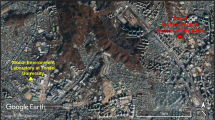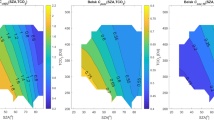Abstract
Radiative transfer model simulations were used to investigate the erythemal ultraviolet (EUV) correction factors by separating the UV-A and UV-B spectral ranges. The correction factor was defined as the ratio of EUV caused by changing the amounts and characteristics of the extinction and scattering materials. The EUV correction factors (CFEUV) for UV-A [CFEUV(A)] and UV-B [CFEUV(B)] were affected by changes in the total ozone, optical depths of aerosol and cloud, and the solar zenith angle. The differences between CFEUV(A) and CFEUV(B) were also estimated as a function of solar zenith angle, the optical depths of aerosol and cloud, and total ozone. The differences between CFEUV(A) and CFEUV(B) ranged from −5.0% to 25.0% for aerosols, and from −9.5% to 2.0% for clouds in all simulations for different solar zenith angles and optical depths of aerosol and cloud. The rate of decline of CFEUV per unit optical depth between UV-A and UV-B differed by up to 20% for the same aerosol and cloud conditions. For total ozone, the variation in CFEUV(A) was negligible compared with that in CFEUV(B) because of the effective spectral range of the ozone absorption band. In addition, the sensitivity of the CFEUVs due to changes in surface conditions (i.e., surface albedo and surface altitude) was also estimated by using the model in this study. For changes in surface albedo, the sensitivity of the CFEUVs was 2.9%–4.1% per 0.1 albedo change, depending on the amount of aerosols or clouds. For changes in surface altitude, the sensitivity of CFEUV(B) was twice that of CFEUV(A), because the Rayleigh optical depth increased significantly at shorter wavelengths.
Article PDF
Similar content being viewed by others
Avoid common mistakes on your manuscript.
References
Anderson, G. P., S. A. Clough, F. X. Kneizys, J. H. Chetwynd, and E. P. Shettle, 1986: AFGL atmospheric constituent profiles (0.120km). Tech. Rep. AFGL-TR-86-0110, Air Force Geophysics Lab., Hanscom Air Force Base, Bedford, Mass.
Antón, M., A. Serradno, M. L., Cancillo, and J. A. García, 2009: An empirical model to estimate ultraviolet erythemal transmissivity. Ann. Geophys., 27, 1387–1398.
Bilbao, J., R. Román, C. Yousif, D. Mateos, and A. de Miguel, 2014: Total ozone column, water vapour and aerosol effects on erythemal and global solar irradiance in Marsaxlokk, Malta. Atmos. Environ., 99, 508–518.
Burrows, W. R., 1997: CART regression models for predicting UV radiation at the ground in the presence of cloud and other environmental factors. J. Appl. Meteor., 36(5), 531–544.
Calbó, J., D. Pagès, and J. A. González, 2005: Empirical studies of cloud effects on UV radiation: A review. Rev. Geophys., 43(2), doi: 10.1029/2004RG000155.
Caldwell, M. M., L. O. Björn, J. F. Bornman, S. D. Flint, G. Kulandaivelu, A. H. Teramura, and M. Tevini, 1998: Effects of increased solar ultraviolet radiation on terrestrial ecosystems. Journal of Photochemistry and Photobiology B: Biology, 46(1-3), 40–52.
Casale, G. R., D. Meloni, S. Miano, S. Palmieri, A. M. Siani, and F. Cappellani, 2000: Solar UV-B irradiance and total ozone in Italy: Fluctuations and trends. J. Geophys. Res., 105(D4), 4895–4901.
den Outer, P. N., H. Slaper, and R. B. Tax, 2005: UV radiation in the Netherlands: Assessing long-term variability and trends in relation to ozone and clouds. J. Geophys. Res., 110, D02203, doi: 10.1029/2004JD004824.
Fioletov, V. E., L. J. B. McArthur, J. B. Kerr, and D. I. Wardle, 2001: Long-term variations of UV-B irradiance over Canada estimated from Brewer observations and derived from ozone and pyranometer measurements. J. Geophys. Res., 106(D19), 23009–23027.
Kaurola, J., P. Taalas, T. Koskela, J. Borkowski, and W. Josefsson, 2000: Long-term variations of UV-B doses at three stations in northern Europe. J. Geophys. Res., 105(D16), 20813–20820.
Kim, J., H. K. Cho, J. Mok, H. D. Yoo., and N. Cho, 2013: Effects of ozone and aerosol on surface UV radiation variability. Journal of Photochemistry and Photobiology B: Biology, 119, 46–51.
Lee, Y. G., J. Kim, H.-K. Cho, B. C. Choi, J. Kim, S. R. Chung, and I. S. Park, 2008: Forecast of UV-index over Korea with improved total ozone prediction and effects of aerosol, clouds and surface albedo. Asia-Pacific J. Atmos. Sci., 44(4), 381–400.
Lee, Y. G., J.-H. Koo, and J. Kim, 2015: Influence of cloud fraction and snow cover to the variation of surface UV radiation at King Sejong station, Antarctica. Atmos. Res., 164–165, 99–109.
Madronich, S., R. L. McKenzie, L. O. Björn, and M. M. Caldwell, 1998: Changes in biologically active ultraviolet radiation reaching the Earth’s surface. Journal of Photochemistry and Photobiology B: Biology, 46(1–3), 5–19.
Mateos, D., J. Bilbao, A. de Miguel, and A. Pérez-Burgos, 2010: Dependence of ultraviolet (erythemal and total) radiation and CMF values on total and low cloud covers in Central Spain. Atmospheric Research, 98(1), 21–27.
Mayer, B., and A. Kylling, 2005: Technical note: The libRadtran software package for radiative transfer calculations—description and examples of use. Atmos. Chem. Phys., 5, 1855–1877.
Mayer, B., G. Seckmeyer, and A. Kylling, 1997: Systematic longterm comparison of spectral UV measurements and UVSPEC modeling results. J. Geophys. Res., 102(D7), 8755–8767.
McKinlay, A. F., and B. L. Diffey, 1987: A reference action spectrum for ultra-violet induced erythema in human skin. Human Exposure to Ultraviolet Radiation: Risks and Regulations, W. F. Passchier and B. F. M. Bosnajakovic, Eds., Elsevier, 83–87.
McKenzie, R. L., W. A. Matthews, and P. V. Johnston, 1991: The relationship between erythemal UV and ozone, derived from spectral irradiance measurements. Geophys. Res. Lett., 18(12), 2269–2272.
McKenzie, R. L., P. J. Aucamp, A. F. Bais, L. O. Björn, M. Ilyas, and S. Madronich, 2011: Ozone depletion and climate change: impacts on UV radiation. Photochemical & Photobiological Sciences, 10(2), 182–198.
Molina, L. T., and M. J. Molina, 1986: Absolute absorption cross sections of ozone in the 185-to 350-nm wavelength range. J. Geophys. Res., 91(D13), 14501–14508.
Nichol, S. E., G. Pfister, G. E. Bodeker, R. L. McKenzie, S. W. Wood, and G. Bernhard, 2003: Moderation of cloud reduction of UV in the Antarctic due to high surface albedo. J. Appl. Meteor., 42, 1174–1183.
Park, S. S., Y. G. Lee, and J. H. Kim, 2015: Impact of UV-A radiation on erythemal UV and UV-index estimation over Korea. Adv. Atmos. Sci., 32(12), 1639–1646, doi: 10.1007/s00376-015-4231-7.
Setlow, R. B., 1974: The wavelengths in sunlight effective in producing skin cancer: A theoretical analysis. Proceedings of the National Academy of Sciences of the United States of America, 71(9), 3363–3366.
Shettle, E. P., 1989: Models of aerosols, clouds, and precipitation for atmospheric propagation studies. Paper Presented at Conference on Atmospheric Propagation in the UV, Visible, IR, and MM-Wave Region and Related Systems Aspects, NATO Adv. Group for Aerosp. Res. and Dev., Copenhagen.
Smith, R. C., Z. M. Wan, and K. S. Baker, 1992: Ozone depletion in Antarctica: Modeling its effect on solar UV irradiance under clear-sky conditions. J. Geophys. Res., 97(C5), 7383–7397.
Seckmeyer, G., A. Bais, G. Bernhard, M. Blumthaler, B. Johnsen, K. Lantz, and R. McKenzie, 2010a: Instruments to measure solar ultraviolet radiation part 3: Multi-channel filter instruments, Technical Report No. 190, WMO/TD-No. 1537, WMO, Global Atmospheric Watch, 55 pp.
Seckmeyer, G., A. Bais, M. Blumthaler, S. Drüke, P. Kiedron, K. Lantz, R. McKenzie, and S. Riechelmann, 2010b: Instruments to measure solar ultraviolet radiation part 4: Array Spectraoradiometers, Technical Report No. 191, WMO/TDNo. 1538, WMO, Global Atmospheric Watch, 43 pp.
Author information
Authors and Affiliations
Corresponding author
Rights and permissions
About this article
Cite this article
Park, S.S., Jung, Y. & Lee, Y.G. Spectral dependence on the correction factor of erythemal UV for cloud, aerosol, total ozone, and surface properties: A modeling study. Adv. Atmos. Sci. 33, 865–874 (2016). https://doi.org/10.1007/s00376-016-5201-4
Received:
Revised:
Accepted:
Published:
Issue Date:
DOI: https://doi.org/10.1007/s00376-016-5201-4




